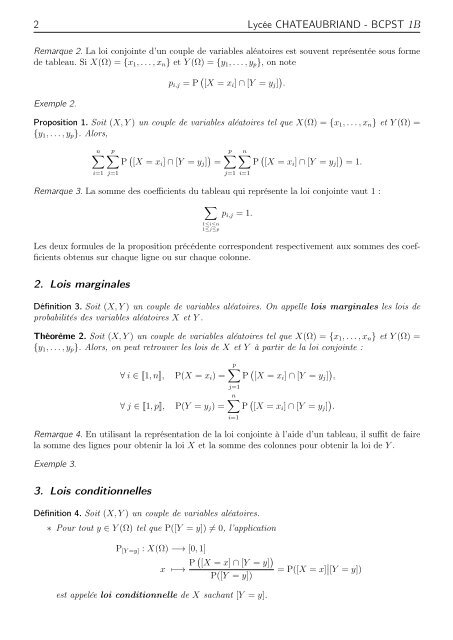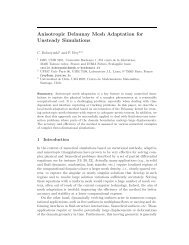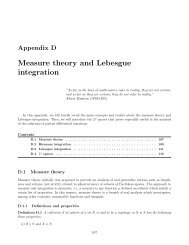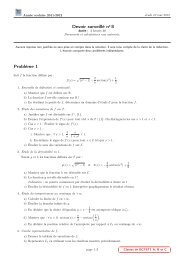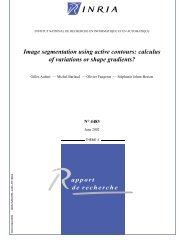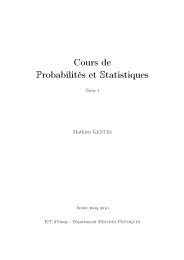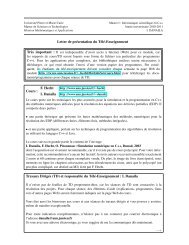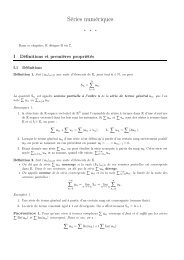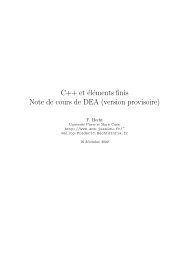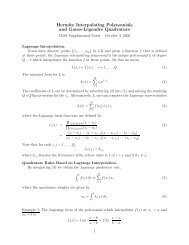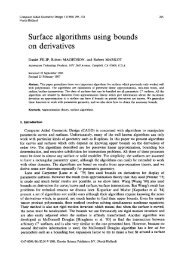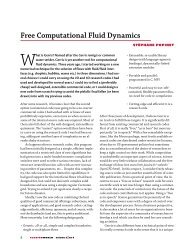Couples de variables aléatoires
Couples de variables aléatoires
Couples de variables aléatoires
You also want an ePaper? Increase the reach of your titles
YUMPU automatically turns print PDFs into web optimized ePapers that Google loves.
2 Lycée CHATEAUBRIAND - BCPST 1B<br />
Remarque 2. La loi conjointe d’un couple <strong>de</strong> <strong>variables</strong> <strong>aléatoires</strong> est souvent représentée sous forme<br />
<strong>de</strong> tableau. Si X(Ω) = {x1, . . . , xn} et Y (Ω) = {y1, . . . , yp}, on note<br />
Exemple 2.<br />
pi,j = P [X = xi] ∩ [Y = yj] .<br />
Proposition 1. Soit (X, Y ) un couple <strong>de</strong> <strong>variables</strong> <strong>aléatoires</strong> tel que X(Ω) = {x1, . . . , xn} et Y (Ω) =<br />
{y1, . . . , yp}. Alors,<br />
n<br />
i=1<br />
p<br />
P [X = xi] ∩ [Y = yj] =<br />
j=1<br />
p<br />
j=1<br />
n<br />
P [X = xi] ∩ [Y = yj] = 1.<br />
Remarque 3. La somme <strong>de</strong>s coefficients du tableau qui représente la loi conjointe vaut 1 :<br />
<br />
1≤i≤n<br />
1≤j≤p<br />
i=1<br />
pi,j = 1.<br />
Les <strong>de</strong>ux formules <strong>de</strong> la proposition précé<strong>de</strong>nte correspon<strong>de</strong>nt respectivement aux sommes <strong>de</strong>s coefficients<br />
obtenus sur chaque ligne ou sur chaque colonne.<br />
2. Lois marginales<br />
Définition 3. Soit (X, Y ) un couple <strong>de</strong> <strong>variables</strong> <strong>aléatoires</strong>. On appelle lois marginales les lois <strong>de</strong><br />
probabilités <strong>de</strong>s <strong>variables</strong> <strong>aléatoires</strong> X et Y .<br />
Théorème 2. Soit (X, Y ) un couple <strong>de</strong> <strong>variables</strong> <strong>aléatoires</strong> tel que X(Ω) = {x1, . . . , xn} et Y (Ω) =<br />
{y1, . . . , yp}. Alors, on peut retrouver les lois <strong>de</strong> X et Y à partir <strong>de</strong> la loi conjointe :<br />
∀ i ∈ [1, n], P(X = xi) =<br />
∀ j ∈ [1, p], P(Y = yj) =<br />
p<br />
P [X = xi] ∩ [Y = yj] ,<br />
j=1<br />
n<br />
P [X = xi] ∩ [Y = yj] .<br />
Remarque 4. En utilisant la représentation <strong>de</strong> la loi conjointe à l’ai<strong>de</strong> d’un tableau, il suffit <strong>de</strong> faire<br />
la somme <strong>de</strong>s lignes pour obtenir la loi X et la somme <strong>de</strong>s colonnes pour obtenir la loi <strong>de</strong> Y .<br />
Exemple 3.<br />
3. Lois conditionnelles<br />
Définition 4. Soit (X, Y ) un couple <strong>de</strong> <strong>variables</strong> <strong>aléatoires</strong>.<br />
∗ Pour tout y ∈ Y (Ω) tel que P([Y = y]) = 0, l’application<br />
P[Y =y] : X(Ω) −→ [0, 1]<br />
i=1<br />
x ↦−→ P [X = x] ∩ [Y = y] <br />
P([Y = y])<br />
est appelée loi conditionnelle <strong>de</strong> X sachant [Y = y].<br />
= P([X = x] [Y = y])


